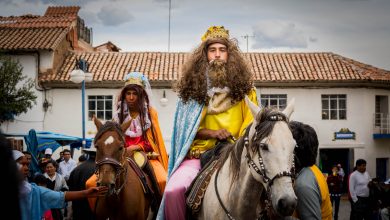A Complex of Activities and Diverse Perspectives, Holy Week in Cusco

Holy week is a web of activities knit from many threads: those of events organized and held in the city’s churches, those of civic organization, those of the city’s markets and businesses and those of Cuzco’s families. Together they make a dense and tightly woven festive cloth in which, despite the power of the Church, no single thread can be the one that is essential.
This is true, even though if you just look at the calendar of events published by the arch diocese you only see the intramural happenings to wish the Church grants priority, as if these could be truly separated. Nonetheless, that definitional separation is supposed in this publication.
People who are visiting the city will see many more things performed with great passion by the city and region’s people. Though intertwined with the Church they are also potentially separable as extramural, folklore, or even popular religion, though these terms are almost never thought of by those who live and experience Holy week in the city
You will see the external entrances to the churches as well as ordinary streets become markets in which vendors and artisans offer palm leaves, crosses made of palms, and auguries of good fortune such as sheaves of wheat. These may be taken into the churches to be blessed with holy water, or they may simply be taken home as a way of bringing the power of the festivity into the house and accompanying it with sacrality throughout the year since they will be placed on doorways and walls to bring the holy in.
In addition, people obtain cactus crosses to put over their doors in their homes. These connect with the local landscape and its holiness, perhaps, more than with the Church.

Especially for Holy Monday, collectors and vendors will bring in the red flowers they have harvested in the surrounding countryside, the ñuqchu flowers as offerings to the Lord of Temblors. The flowers that fall from him will then be gathered by people watching the Lord’s procession to take home with them.
We might call these indices (indexes) of the sacred: whether enshrined in the Church, the earth, society through offerings, or the Holy figure of the Lord.
But there is more. The markets also fill with special pastries for Holy Week that are typical of Cusco, such as the famous empanada, as well as the maicillos, rosquillas, suspiros, condesas, and jurqa breads. People buy these to eat at home in recognition of Holy Week, but they are also typically Cusqueño so when people travel during this time they will take these to share with friends and relatives in other cities.

People also climb the hills in devotion, a kind of pilgrimage in which they take on Christ’s scourging.
And, in their homes they eat the twelve dishes of Holy Week on Thursday in memory of Christ’s death on the cross, before gathering as a family on Sunday to spend time together and celebrate the resurrection with their loved ones as families.
In synthesis, Holy Week, includes many activities of which only a small part are carried out in the Church, even though as a whole they permit the people of Cusco to join the events where they will. They can center themselves in the Church, or even pay it almost no heed as thy celebrate this feast with its three bases, the Church, nature, and society.




